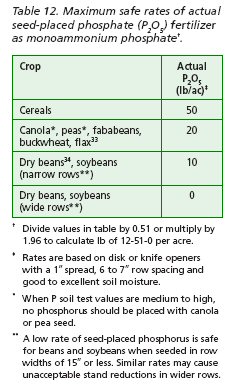Soil Fertility Guide
Phosphorus (P)
The majority of Manitoba soils cannot supply adequate phosphorus (P) for optimum yields. In recent years, some 25% of fields are rated as very low and low in P 31 . Unlike nitrogen, phosphorus levels do not change from year to year in response to climatic conditions, most crop rotations or crop management practices.
Losses of P into surface water will decrease water quality. Beneficial management practices (BMPs) to manage P include:
- Regular soil testing and appropriate fertilizer applications
- Soil conservation practices such as conservation tillage, forages and buffer strips where losses are related to particulate P from soil erosion
The P content of seedling plants need to be high in order to achieve maximum yields. Placing P fertilizer where developing roots can access it rapidly is critical in attaining these high P levels in young plants. Additionally, the high pH calcareous soils that predominate in Manitoba tend to "fix" or reduce the availability of applied P and slow the build up of soil test levels. For this reason, P use is most efficient when soil contact with fertilizer is limited, such as by banding.

Phosphorus efficiency is greatest when applied with the seed, providing the amount does not injure the germinating seedling 32 . Some crops, such as oilseeds and pulse crops, are sensitive to seed-placed phosphate, whereas cereals can tolerate their total fertilizer P requirement placed with the seed (Table 12).
Monoammonium phosphate (11-52-0) has a low salt index and does not produce much ammonia, so it has relatively low toxicity to seedlings. Phosphate fertilizer banded near the seed (beside and/or below) results in the greatest yield increase per unit of P when recommended rates exceed that tolerated with seedplaced application. Such side-banded applications are recommended for most oilseeds, annual legumes and row crops. Deep banding phosphate at the 4-6" soil depth and in spacings of 12" or less before seeding or midrow banding during seeding are more effective in increasing yields than broadcast and incorporation methods. Banding nitrogen with the phosphate will increase fertilizer P availability. Band these fertilizers together when both N and P are needed. Application of 10 to 15 lb P 2O 5/ac with or near the seed may also be required to ensure adequate P supplies for early growth before roots can proliferate in the fertilizer bands. Application of additional phosphate with or near the seed may be especially beneficial when soils are cold and/or very deficient in P or when the phosphate is dual banded with a high rate of urea N in spring. Broadcast and incorporated phosphate results in the lowest yield increase per unit of P fertilizer. Broadcast application of P may be uneconomical on many soils, since the amount required in the first few years is two to four times that of seed-placed P to achieve similar yield increase. Crops such as flax may suffer reduced stands and yield when high rates of phosphorus are seed-placed. Recent studies demonstrate that modest rates of P can be seed-placed with flax without reducing yield. This rate of 20 lb P 2O 5/ac is sufficient to meet the crop removal of a 30 bu/ac flax crop.
Most crops will respond to properly applied fertilizer phosphate when the available soil P level is low. The probability and degree of response, as well as the amount of fertilizer P required, will decrease as the level in the soil increases. Up to a third of the time, cereal crops will respond to a small amount (e.g. 10 lb/ac) of seed placed phosphate even when the soil test level is relatively high. This is commonly called the "pop-up effect" and occurs particularly under cold, dry soil conditions at seeding time. Repeated applications of relatively high rates of phosphate fertilizer may slowly increase available P content of some soils. Manured fields tend to have higher P soil test values, often related to the frequency, amount and type of manure applied. A seed-applied inoculant called JumpStart (Registration #900025A, #920064A, Fertilizers Act) is a natural occurring fungus (Penicillium bilaii) that grows on plant roots and makes residual soil P more available for plant uptake. It is registered for use on wheat, peas, lentils, dry bean, chickpea, canola, mustard, sweet clover and alfalfa. When used on soils testing low or medium in P, accompanying fertilizer phosphate rates should not be reduced. On high to very high P testing soils, JumpStart may be used in place of the starter phosphate fertilizer. JumpStart is not residual and needs to be applied annually. A beneficial fungus called mycorrhizae (or "fungus root") occurs naturally in our prairie soils. This fungus colonizes the roots of most plants and through fungal strands or hyphae, assists in the interception and uptake of immobile nutrients, especially phosphorus and zinc. This fungus contributes substantially to early season P uptake in crops such as corn, flax, sunflower and soybeans. However mycorrhizae do not colonize members of the Brassica family (i.e. canola, mustard) and the population is quite low following these crops or after fallow. Consequently, succeeding crops may suffer an impaired ability to take up phosphorus and have reduced growth and yield. Crops such as cereals are often sown with phosphate fertilizer close to the seed and do not appear to suffer as greatly from the lack of effective mycorrhizae following canola or fallow. Mycorrhizae appear to be more effective in taking up phosphorus on low P soils and on undisturbed soils such as zero till where mycorrhizal hyphae remain intact. For further information, contact your MAFRD GO Representative.
|

